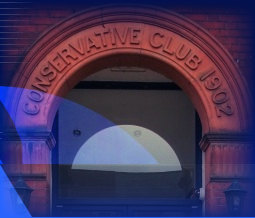


 |
|||||||||||||||||
|
|
|
||||||||||||||||
|
|
|||||||||||||||||
 |
|
|
|
Some History of the Newton Road Conservative Club
The Club was founded in 1902, with the inaugural meeting being held on 11th September of that year. The original site consisted of a rectangle of land that included the current building and the car park behind it, but not the bowling green nor that part of the car park behind it. The site was 94 x 150 feet (52 square rods) and was acquired for the sum of £325. The club building was erected by Messrs Cooper and Howard at a cost of £1,165. This was partly funded by a mortgage on the club of £750 to J.D. Cobbold and the club had to pay an annual rent of £120. By early the next year the club had over 200 members. Until the 1970s the club was owned by a company (Newton Road Conservative Club Limited), which had directors who could expect to be paid fees and shareholders who expected to be paid dividends. A flag pole was erected in 1909 at a cost of £4 and 10 shillings. In 1909 the club asked for a reduction in the annual rent of £10 which was initially refused by the directors, but in 1910 a £20 reduction was granted to compensate for the effects of Lloyd George’s “People’s Budget” of 1909. In 1913 iron railings were erected in front of the club at a cost £22 8 shillings and sixpence. In 1914 Frank Bales a director of the club and its first secretary resigned. His name is on one of the stones next to the club entrance. He was a local businessman who ran a gun making business which he inherited from his father, initially in the Cornhill, but later in Lower Orwell Street. Later on he seems to have become a wine & spirit merchant. The club premises were used by the army during the First World War – there is a reference in the minutes of the committee in 1918 referring to damage sustained during military occupation. In 1924 the club bought the house at number 8 Alan Road for £1,100. At the time the house came with land that extended through to Newton Road. The initial intention was to sell the house less the land that was adjacent to the club for £600 and a plot of land next to the house for £150. The land that was kept by the club was used to create a new bowling green, together with two tennis courts and two quoit beds. The billiard room was also extended to allow for another table. The house must have proved harder to sell than they expected, as after 6 months they sold the house and the adjoining plot for £700 (£50 less than intended). In 1925 a new billiard room and a ladies lavatory and cloakroom were built at a cost of £494 and in 1926 the club got electric lighting at a cost of £62 2 shillings and sixpence (presumably it was originally gas). In 1948 the club’s office was converted into a kitchen and part of the existing smoke room was converted to a new office. In 1954 the club was in financial difficulties and a meeting was held between the company and representatives from the club. No dividend was paid out to the shareholders the following year. In 1957 the club provided a bathroom for the steward. In 1966 the club car park was resurfaced at a cost of £456 1 shilling, half of which was paid by the club and the other half by the company. During the 1970s the committee bought the shares in the club that it didn’t already own, thus dispensing with the need to pay director’s fees and dividends. During the 1990s the club building underwent extensive refurbishment to become as it is today.
The above is a somewhat brief history and during the 110 years of the club’s history far more than this has happened. If anyone has any interesting facts that could be added or pictures of the club buildings or its grounds we would like to hear from them. |
||
|
|
||
| Site Map |